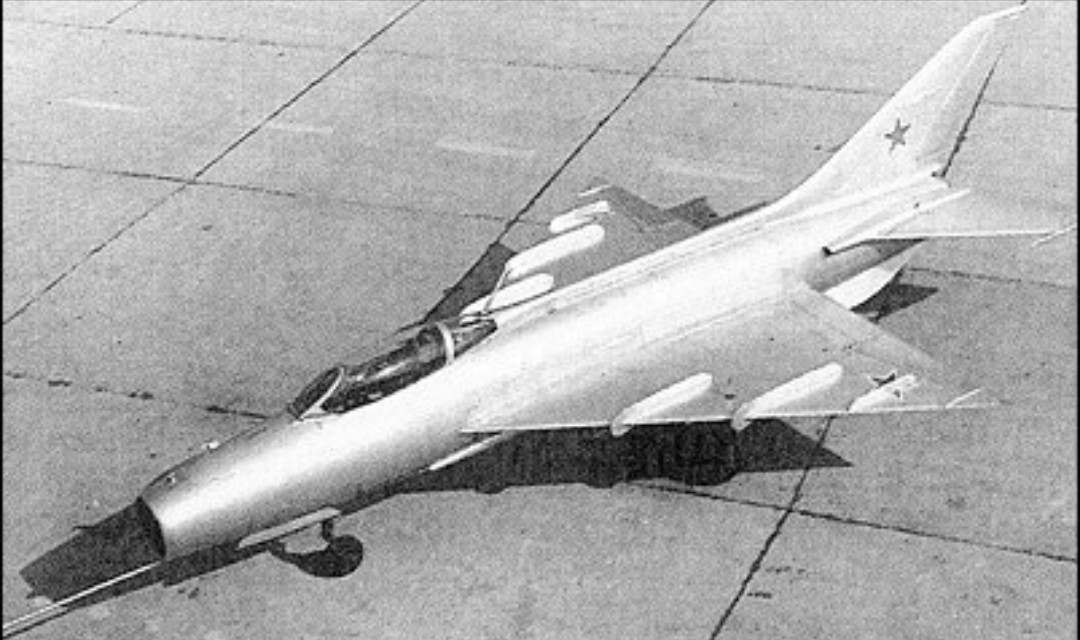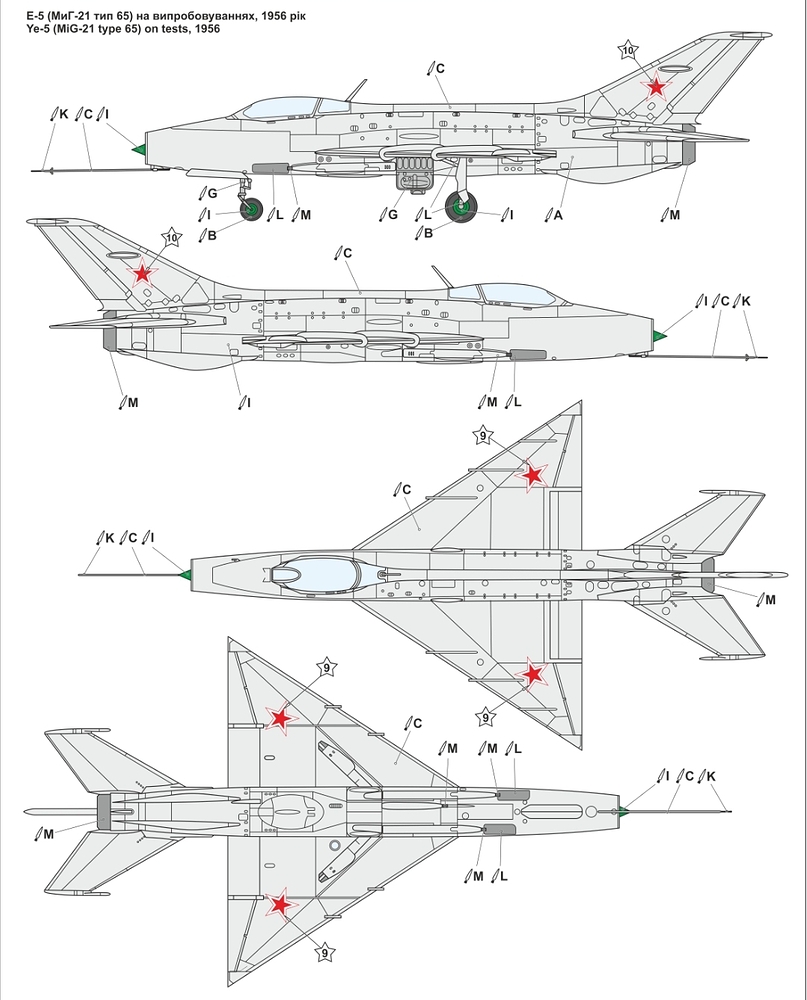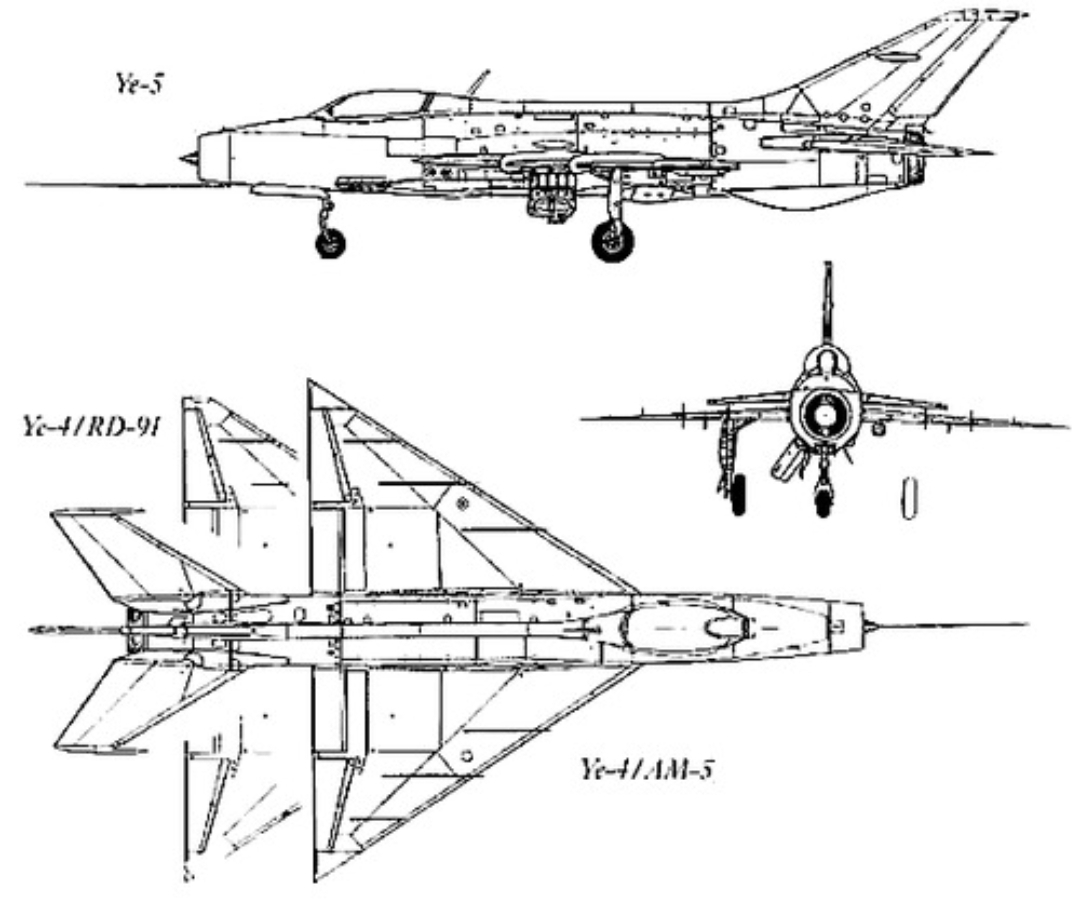Would you like to see this Fishbed in-game?
MiG-21 (Izdeliye 65) Fishbed-A
I would like to suggest the very first batch of MiG-21 fighter jets. These aircraft stand out from later versions because they were armed with three NR-30 cannons, offering much better firepower than the twin-barrel GSh-23 fitted to most subsequent MiG-21s. At the same time, these jets had their limitations. They were equipped with early engines, leaving them slightly less powerful than the more refined MiG-21F-13 and later variants. In addition, these jets carried no guided missiles and relied entirely on their fixed cannon battery. A source says that it could also carry unguided rockets, bombs, and/or a drop tank, although I could not confirm this. In any case, they had arguably the heaviest cannon armament of the entire MiG-21 family.
History
Spoiler
The path toward the MiG-21 began in the early 1950s when the Soviet Air Force demanded a new generation of lightweight, Mach 2-capable interceptors. Mikoyan’s design bureau responded by exploring two distinct aerodynamic solutions: one based on swept wings and another based on the delta wing. This dual approach allowed engineers to compare and refine competing designs under real conditions, as the Soviets were determined to achieve speed, altitude, and agility superior to their existing MiG-19 fighters.
The first delta-wing experiment, designated Ye-4, flew in 1955. Although it represented an important step forward, its performance fell short of expectations, struggling to exceed Mach 1.2 and failing to reach the desired service ceiling. Engineers quickly realized that improvements in engine power and aerodynamics were essential if the delta concept was to succeed. The answer came in the form of the Ye-5, also known under its internal designation I-500. This prototype was fitted with the new AM-11 turbojet, later standardized as the Tumansky R-11, and incorporated refined structural features. When it took to the air in January 1956, it immediately demonstrated the potential of the delta wing. The Ye-5 achieved speeds approaching Mach 2, climbed to ceilings above 17,000 meters, and displayed agility superior to its swept-wing rival, the Ye-2. Its appearance at the Soviet Aviation Day display in June of that year marked a turning point, showing both Soviet leadership and Western observers that the design was on the threshold of production.
With the Ye-5 proving successful, the Soviet Union authorized a limited pre-production batch of MiG-21 Izdeliye 65 aircraft for further testing and refinement. These early machines entered Western reporting under the codename “Fishbed-A.” They were essentially productionized Ye-5s, retaining the three-gun layout and many of the prototype’s design features. Only a handful were built, serving as a bridge between the experimental stage and the true production MiG-21. The lessons learned with these early aircraft led directly to the MiG-21F, the first truly operational versions. However, the MiG-21F carried only two cannons, a configuration already represented in War Thunder by the J-7.
Characteristics
Spoiler
Technically, the MiG-21 (Iz. 65) remained simple by later standards but advanced for its time. Its compact delta wing, nose intake with conical shock diffuser, and small fuselage gave it the lightweight qualities the air force wanted. The AM-11 turbojet produced over five tons of thrust with afterburner, which gave the prototype its near-Mach 2 performance. Internal fuel capacity was modest, limiting range to little more than 1,200 kilometers without auxiliary tanks, but this was accepted since the type was intended as a short-range point-defence interceptor. Avionics were equally basic, consisting of a small radar rangefinder paired with a gyroscopic gunsight, radio and navigation sets, an identification transponder, and a simple radar warning receiver. The emphasis remained firmly on speed and climb rather than electronics.
Where the MiG-21 (Iz. 65) was most distinctive was in its armament. It carried three NR-30 cannons, one mounted beneath the nose and two on the fuselage sides near the intake. Each gun carried about sixty rounds, giving the aircraft a fearsome burst of fire. This choice was rooted in recent combat experience. Soviet designers believed that a supersonic dogfight would allow only the briefest firing opportunities, so maximum hitting power in a single pass was critical. The philosophy carried over from the MiG-15 and MiG-19, both of which had been heavily armed with multiple cannons. At the time, guided air-to-air missiles were still experimental, so the guns were considered the aircraft’s primary means of attack.
Implementation
Spoiler
I believe this would be a really interesting aircraft to bring into War Thunder. Its main draw is obviously the armament: three NR-30 cannons. These guns are superior to the GSh-23 found on most other MiG-21s thanks to their higher muzzle velocity and larger calibre. Although the ammunition supply per barrel is limited, the aircraft makes up for that by carrying three of them. Even the Chinese J-7 only has two. However, Its main handicap is the absence of missiles, but in all honesty the R-3S is almost useless anyway. In exchange, this early MiG-21 gets a lot more cannon ammunition than the F-13, and it avoids the slight performance penalties that missiles and their pylons bring with them. The Fishbed-A could also be an intriguing option in Ground RB. The triple NR-30s deliver a harder punch than even the Su-7’s cannon armament. Sources say that the aircraft could carry very heavy unguided rockets, as well as bombs. The trade-off is that it likely would not have access to a ballistics computer, meaning players would have to rely on skill for ground attack accuracy.
Specifications
Spoiler
General Characteristics
- Type: Light front-line fighter, designed for daytime use in clear weather
- Crew: 1 pilot
- Dimensions:
- Length: approx. 13.4 m
- Wingspan: 7.75 m
- Height: ~4.1 m
- Wing area: ~23 m² (delta wing)
- Weight:
- Empty: ~4,800–5,000 kg
- Normal take-off: ~6,800–7,000 kg
- Maximum take-off: ~8,200 kg
Powerplant
- Engine: One Tumansky R-11-300 (AM-11) axial-flow turbojet
- Thrust:
- 3,800 kp (37.3 kN) dry
- 5,100 kp (50.0 kN) with afterburner
- Fuel Capacity: ~2,280 liters internal, plus optional 400 liter drop tank under fuselage
Performance
- Maximum Speed:
- ~1,950–2,000 km/h at altitude (Mach 1.9)
- ~1,100–1,150 km/h near sea level
- Service Ceiling: ~17,500 m
- Range:
- 1,200–1,300 km on internal fuel
- Rate of Climb: ~120–150 m/s
Avionics and Systems
- Radar: SRD-1M Radal-M ranging radar (effective from 0.3 to 2 km), with small dorsal nose-mounted antenna ahead of cockpit
- Gunsight: ASP-5N-V3 gyro gunsight
- Defensive Systems:
- SRO-2 “Chrom” (Odd Rods) IFF
- SPO-2 “Sirena-2” radar warning receiver
- Hydraulics: Two independent hydraulic systems, one reserved for powered flight control surfaces
- Airbrakes: Three total (two lateral underwing, one ventral)
Armament
- Fixed: Three NR-30 30 mm cannons (one centreline, two side-mounted), each with 60 rounds
Unconfirmed Armament
- Stores:
- 400 liter drop tank
- FAB-250 bomb (250 kg)
- ORO-57 rocket pod (8×57 mm ARS-57 rockets)
- ORO-190 launcher (190 mm TRS-190 rocket)
- one ARS-212 (212 mm unguided rocket)
Sources
Spoiler
R-11 (LeteckeMotory.cz)
Je-5/MiG-21 (Fishbed A) :: Ruslet
Фронтовой истребитель, истребитель-перехватчик МиГ-21 (Е-6, "Fishbеd" ) (1955г.)
List of Mikoyan-Gurevich MiG-21 variants - Wikipedia





